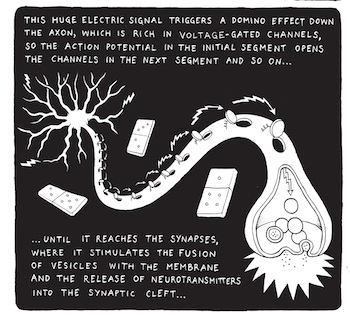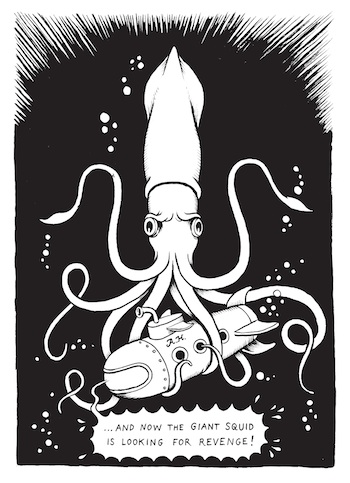As imaging techniques have birthed a new wave of brain-centric research, it’s also created a slew of problematic journalism. Neuroscience is a complicated–and young–stem of research, where imaging conveys a host of unknowns that can only be interpreted as correlations–difficult when the role of a journalist is to break things down into their most simplistic translation and apply the information directly to human health and behavior.
But the authors of Neurocomic, a graphic novel written by two neuroscientists, hope that translating the brain into a visual, engaging format will provide a better scope to learn basic knowledge about neuroscience. They also use the narrative freedom of fiction to create more imaginative tools to explore the intricacies of the mind: Over the course of the graphic novel, their heroine battles a giant squid, travels by submarine, and journeys through a haunted castle in an effort to help visualize the complicated inner workings of the brain. Matteo Farinella and Dr. Hana Ros spoke to CJR from their laboratory at the University College London a few weeks after the comic’s release about what lessons journalists can learn from fiction writers and translating brain science for the masses.
How did you end up collaborating?
Matteo Farinella: We work in the same lab at the University of College London. She’s more science than me: I was doing my PhD in Computational neuroscience–a very very geeky branch of neuroscience–and she had arrived after a couple of years as a postdoc. So we were just being scientists, then she found out that I was drawing and said, “Hey, why don’t we write a comic about neuroscience?” She had the ambition.

How did working together influence the final product?
MF: I think I had the idea of the main things I wanted to represent. The brain as a forest of neurons is an old metaphor from neuroscience, so I’ve always wanted to draw the brain as a forest. I wanted to do more adventure, which she didn’t like.
Hana Ros: The first draft didn’t have any female characters, so I was like, “No, we’re definitely having females in there.” It’s getting the balance between making it a fun narrative and actually getting some information across.
MF: When you have different interests in different ends of neuroscience, you paint a different picture. We are friends, so Hana could tell me, “This is boring; this doesn’t make any sense; redraw it.”
One of the hardest things in depicting the brain is making abstract concepts concrete; How did you tackle this problem?
MF: The last chapter is all about consciousness. The theory was to present the conscious as this inner narration of your brain. The way we approached the last chapter is that the character ends up in this haunted, very dark castle, and there’s this voice talking to him, and the character is talking to him and getting very paranoid and is looking for someone to blame. And at the end they are looking around for this voice, but when they think they’ve found the voice when they open the curtain there’s a mirror. Is that a metaphor?
HR: We had a funny situation with our professor who specializes in synaptic vesicles. Basically he looked at the drawing and was saying, “You’re misrepresenting the way the net is holding the vesicles.” But we can’t show the net in any other way–they’re like these little balls containing the neurotransmitters–so it’s the right balance in having the science right and the right information, but also not being able to show everything perfectly.

We’ve written often at CJR on bad journalism about neuroscience. Are there ways that fiction is a better mechanism for communicating something so abstract?
MF: There is a lot of focus on imaging neuroscience, because it’s more accessible, so it’s easy for people to write an article about this. But I think there’s a lot of interest in: What is a neuron? How does it work electrically? Which maybe for a journalist is difficult to write about, but in a comic you can really show it. Hopefully if people start to understand these things, they can start to write about them.
HR: I guess you’re trying to simplify it in a fictional way–you have a lot more freedom to express yourself creatively. Whereas when you’re writing a journalism piece, you have to be more factual. Which can get us into trouble, because the more visual we make it, in a fun way, the more difficulties we might have translating a correct message. I would really like to see more science illustrations. It’s what I’m trying to do. In the lab I’m always looking at neurons and seeing how beautiful they look, and I think, “Oh, wouldn’t it be nice if everyone knew how beautiful they are as well?” They just don’t have the opportunity to look. I think that’s the most common element we have, is the visual element.
MF: That’s a good point.
HR: I think for the last 10 years there’s definitely been a lot more interest, because there’s been more advances in neuroscience. Thirty or 50 years ago we didn’t really know much at all, but I guess in the last 10 years there’s so much more. I think it’s just so complicated that people are fascinated with how and why. It’s like the last frontier of space.
Alexis Sobel Fitts is a senior writer at CJR. Follow her on Twitter at @fittsofalexis.
